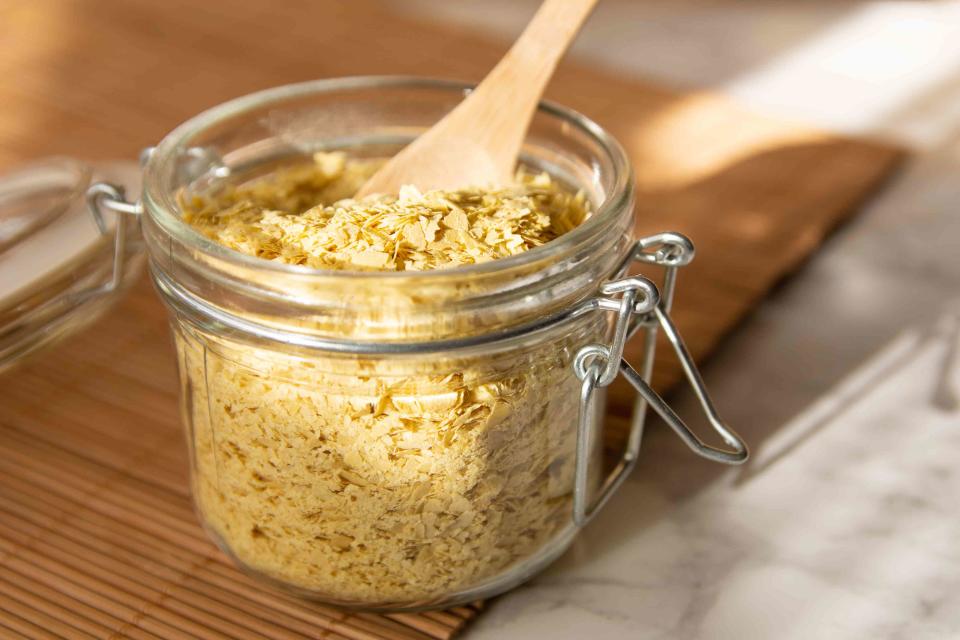A Guide to Nutritional Yeast, the Umami-Packed Vegan Ingredient
This good-for-you seasoning is the secret to cheesy and nutty flavor in vegan dishes and beyond. Here’s everything you need to know before using it in your cooking.

Getty Images
Fans of nutritional yeast have long known that this vegan pantry staple, sold in powder and flake form, is way more delicious than its name implies. Beyond adding cheesy, Parm-like flavor to popcorn or dairy-free takes on pimiento cheese and pasta primavera, umami-packed “nooch” can punch up restaurant-worthy dishes like Cabbage-and-Kale Slaw with Toasted Yeast Dressing. The dairy- and gluten-free ingredient also offers impressive health benefits.
Here’s everything you need to know about nutritional yeast, including what it actually is, where to find it, and how to use it in your cooking.
What is nutritional yeast?
Nutritional yeast comes from Saccharomyces cerevisiae, the same species of wild yeast that is used to bake bread and brew beer. It’s cultivated in large fermentation tanks and fed a sugar-rich liquid, then heated, pasteurized, and dried. During this process the yeast is deactivated and releases amino acids that include glutamic acid — a flavor enhancer that’s present in MSG and umami-forward foods like tomatoes and Parmesan cheese. The yeast is then either pressed into flakes or ground into a powder and, thanks to the glutamic acid, takes on a cheesy, almost nutty flavor that’s somewhat akin to Parmesan.
What’s the difference between nutritional yeast, baker’s yeast, and brewing yeast?
Because the yeast cells are inactive (i.e. dead), nutritional yeast doesn’t have any leavening properties that would cause bread or baked goods to rise like baker’s yeast. Nutritional yeast is also manufactured to be sold as a food product and takes on its distinct cheesy flavor during the deactivation process, while baker’s yeast is intended to be used as a baking ingredient.
Brewer’s yeast, meanwhile, is used to brew beer; the byproduct is often heat-treated and sold in its inactive form as a nutritional supplement or a cooking ingredient. While it offers similar health benefits as nutritional yeast, including a host of B vitamins, brewer’s yeast has a more bitter flavor that’s less often used in cooking.
Is nutritional yeast good for you?
Yes! “Nutritional yeast contains all nine essential amino acids, i.e. the ones you have to get through food that we don’t make in our bodies,” says F&W senior food editor Breana Killeen, M.P.H., RD. It’s an excellent source of B vitamins including Vitamin B12, which is particularly important for those who don’t eat animal protein, and folate, which promotes nerve growth. What’s more, it’s low in calories and offers immune-boosting minerals like selenium and zinc that most people don’t get enough of in their diets, Killeen adds.
Nutritional yeast also contains an impressive amount of protein for those following a plant-based diet. “For every two teaspoons of nutritional yeast, you get three grams of protein, which is not nothing,” says Killeen. “For comparison, one ounce of nuts provides about six grams of protein and a half cup of beans is eight grams of protein.”
How to use nutritional yeast in your cooking
In flake or powder form, nutritional yeast is often used as a seasoning for popcorn, roasted veggies, or pasta. It also adds a cheesy, Parm-like flavor to vegan and vegetarian recipes like Vegetarian Meatballs, Vegan Pimento Cheese, Vegan Tofu Scramble, or the panko topping for Creamy Vegan Pasta Primavera.
Nutritional yeast isn’t strictly for vegan or vegetarian cooking, though. F&W’s Justin Chapple suggests sprinkling nutritional yeast on a mayo-slathered grilled cheese before cooking for a delectably crispy and umami-forward crust; Chef Josh Lewis toasts the yeast and adds it to the dressing for his Cabbage-and-Kale Slaw. 2021 F&W Best New Chef Carlo Lamagna uses a mix of bread flour and nutritional yeast in the eggless miki noodles for his Pancit Miki Bihon, while 2018 Best New Chef Jonathan Yao makes his Fortified Soy Sauce with an umami quintuple-threat of nutritional yeast, bonito flakes, dark soy sauce, mirin, and sake.
Nutritional yeast can also be used to help thicken sauces, soups, broths, salad dressings, and dips. If the form of nutritional yeast isn’t specified in a recipe, you can use either the powder or flakes — they both dissolve well and have the same flavor.
How to buy nutritional yeast
Long a nutrition store staple, bright-yellow nutritional yeast is now widely available at many grocery stores in flake or powder form, sold in shaker jars or bags — look for brands like Bragg and Bob’s Red Mill in the health-food aisle or spice aisle. It’s also often sold loose in bulk bins, where it may be labeled as “yeast flakes.” Nutritional yeast is very shelf-stable and can last in your pantry for up to two years, according to Killeen — just one of many reasons to add this umami bomb to your cooking arsenal.
For more Food & Wine news, make sure to sign up for our newsletter!
Read the original article on Food & Wine.

 Yahoo Finance
Yahoo Finance 